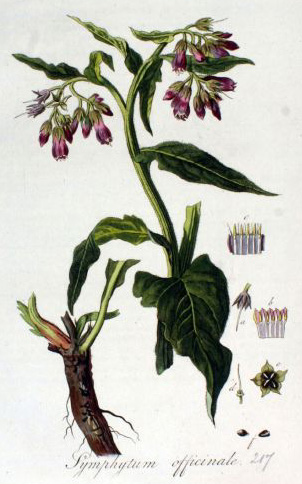 |
The Original
Heirloom, Heritage Comfrey
True, Quaker,
Cultivated or Common Comfrey (Boraginaceae family, S. officinale) is native
to Europe. It likes to grow in damp, grassy locations in full or partial
sun.
The bell-shaped flowers can be creamy yellow, white, red, magenta, pink
or purplish (various shades). It grows to about 3 feet tall including the
flowerstalk. It is smaller than Russian Comfrey.
|
 |
Cold
Hardy, Perennial
Comfrey is
a perennial with roots that are hardy to minus 15 degrees (-15) Fahrenheit.
Though I suspect it can take even colder temperatures because Russian Comfrey
is documented to survive down to -40 degrees.
The leaves can withstand temperatures down to 15 degrees and still be healthy.
Below that temperature the plant goes dormant. (It can survive temperatures
as high as 120 degrees.)
|
 |
Symphytum
Officinale
From the
book "Comfrey: Fodder, Food & Remedy" by Lawrence D. Hills:
"Symphytum officinale-- Its flowers are 3/4 inch long and cream-yellow.
They can be purple but it can be identified by the wide wings that continue
right down the flower stems from leaf to leaf, and the pointed long, narrow
leaves."
This photo is buds before they open.
|
 |
Seeds
Can be Planted
It can be
somewhat invasive from the seeds spreading. If you do not want it to spread,
then cut off the flowerstalks before they go to seed. It is not very invasive
by the roots.
The seeds are viable so it can be propagated by seeds or root cuttings.
Russian Comfrey is a natural hybrid cross between True Comfrey and Prickly
Comfrey (Symphytum asperum).
True comfrey produces biomass (freshly cut leaves) per acre that is about
1/3 that of Russian comfrey.
This drawing from Germany is Symphytum officinale.
|

 |
The
Original Medicinal Comfrey
True / Common Comfrey (Symphytum officinale) has been used for thousands
of years to heal.
In traditional Chinese medicine it has been a remedy for 2,000 years. It
was part of the Materia Medica (body of remedial substances used in the
practice of medicine) of the Middle Ages.
Dioscorides, a physician in 50 A.D., prescribed the plant to heal wounds
and broken bones. It is good for skin problems.
|
 |
True
Comfrey in Spring
This photo is from Mike in Olney, Maryland. The root was planted in October and is shown in spring.
"Looking
forward to my current two comfrey plants being used to create additional
for the future." -Mike, Maryland
"I received
and planted the 2 True Comfrey roots, and they are showing some new leaves
already! Thank you so much!!!" -Carolyn, Austin, Texas
|
 |
Young
Leaves of Comfrey
"I received
and planted the 2 True Comfrey roots, and they are showing some new leaves
already! Thank you so much!!!" -Carolyn, Austin, Texas
|
 |
Properties
of Symphytum Officinale
Very rarely
S. officinale may get comfrey rust (Melampsorella symphyti). People with
small gardens do not usually have much of a problem with it though. Russian
comfrey Bocking #14 is resistant to rust.
The Nitrogen-Phosphorus-Potassium (NPK) ratio of True Comfrey is 1.80-0.50-5.30.
It's leaves are 1.31% calcium, 0.72% phosphorus, 3.09% potash (potassium),
0.098% iron, and 85 ppm manganese.
|
 |
Comfrey
Flowers
Clusters
of bell-shaped comfrey flowers.
"Just wanted to tell you how well your True Comfrey root grew even though I planted it late in June. I was able to harvest the leaves
twice, and a third set of leaves are in the process of maturing (late October). The weather is starting to cool down in NY, and I am sure cold night temperatures are not far off." -Steve, Garden City, New York
|
 |
Many
Flower Colors
True
Comfrey grows with many different colors of flowers. Pollination takes place
between plants with different flower colors. The seed produces a plant with
a new color.
Most of the roots I sell are from plants with deep purple flowers. But you
might get flowers similar to these photos.
|

 |
A Valuable
Plant
"I
am so excited to be getting another start of comfrey. I had it years ago,
but ended up giving nearly every last bit of it away, ending up with sprouts
from hair-sized roots and gave THOSE away, so now I have nothing. I have
been buying many herbs, including comfrey root for general health, using
comfrey poultices to treat various ailments. Thank you so much for making
this great plant so accessible. The value of some things cannot be measured
properly by money alone. Be well, and make the days of your life treasures
to be cultivated along with the comfrey we both treasure." -Wil, Kentwood,
Louisiana
|

 |
Common
Comfrey in Minnesota
"This is
the three roots you sent in April of last year (it is now September). They
have adapted to Minnesota well and leaped out of the ground after the winter.
They are about 4 feet tall, and my wife is muttering about comfrey eating
her strawberry bed. But the bees and bumblebees are quite happy with the
new addition." -Marion, Minneapolis, Minnesota
A happy bumblebee on the Minnesota comfrey.
|
 |
Common
or True Comfrey
$15 each
for a root. Shipping is $7 no matter how many you buy. You can order
other types of comfrey with no extra shipping.
Your
roots will be crown cuttings with leaves trimmed off or a root cutting with
a bud that is ready to grow.
Comfrey
Easy Order Page
|














